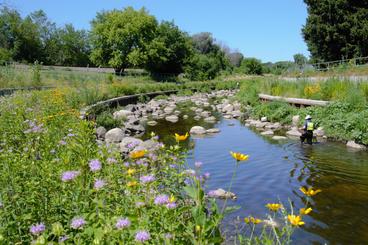
Challenge: Climate change in the Midwest may force species to disperse northward to track suitable habitat conditions, often through highly fragmented landscapes.
Principal Investigator(s):
- Marissa Ahlering (The Nature Conservancy)
Co-Investigator(s):
- Kim Hall (The Nature Conservancy)
- Melissa Clark (The Nature Conservancy)
- Deepak Ray (University of Minnesota)
- Sarah Skikne (University of Minnesota)
Cooperator/Partner(s):
- Jaymi Lebrun (U.S. Fish and Wildlife Service)
- Alison Cariveau (Minnesota Department of Natural Resources)
- Kristin Hall (Minnesota Department of Natural Resources)
- Katie Frerker (U.S. Forest Service)
- Suraj Puadhaya (Iowa State University)
- Robert Croll (Great Lakes Indian Fish and Wildlife Commission)
- Nick Miller (The Nature Conservancy)
Species are adapted to particular environmental conditions, but are threatened as climate change shifts habitat conditions. One way species can respond is by moving to new suitable locations, known as climate-driven range shifts. But some species can move more easily and/or more quickly than others, and some landscapes are more difficult to cross. In the upper Midwest, the movement potential of many species is reduced by broad expanses of row-crop agriculture, roads and other types of development that fragment the remaining habitat. It is important to sustain and improve connectivity across landscapes so they can continue to support biodiversity and ecosystem services like water filtration, carbon storage, pollinator support, or recreational activities.
This project will engage in a collaborative process with land managers and other interested parties to build connectivity models and assessments of ecosystem services to prioritize areas for habitat restoration. Connectivity modeling tools can help explain how species respond to landscape patterns and other important factors like the intensity of climate change exposure in different parts of the landscape.
Outcomes from this project include maps of connectivity and ecosystem service benefits to inform management decisions by conservation practitioners, and a recorded webinar about using the products. By linking wildlife, ecological, and social benefits, these results will help managers better coordinate their actions, and to engage a broader segment of the public in support of these actions.
This project will engage in a collaborative process with land managers and other interested parties to build connectivity models and assessments of ecosystem services to prioritize areas for habitat restoration. Connectivity modeling tools can help explain how species respond to landscape patterns and other important factors like the intensity of climate change exposure in different parts of the landscape.
Outcomes from this project include maps of connectivity and ecosystem service benefits to inform management decisions by conservation practitioners, and a recorded webinar about using the products. By linking wildlife, ecological, and social benefits, these results will help managers better coordinate their actions, and to engage a broader segment of the public in support of these actions.
Read more from CASC Project Explorer.
Project Details
Principal Investigator
Marissa Ahlering
Principal Investigator Organization
The Nature Conservancy
Year
2023
Topic
Landscapes,
Science Tools for Managers,
Wildlife and Plants
Status
In Progress
